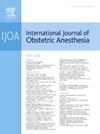使用最大允许失血量计算法进行产科出血风险评估:我们走对路了吗?
IF 2.6
3区 医学
Q2 ANESTHESIOLOGY
引用次数: 0
摘要
加拿大妇产科医师协会 (SOGC) 的产后出血临床指南围绕 6R 框架提出了循证建议:风险评估、降低风险、识别和评估、反应、复苏和回顾。自该指南发布以来,我院已开始实施所有指南建议。其中一项重要建议是计算最大允许失血量(MABL),使每位产科病人的血红蛋白水平达到 70 g/L。引入这一做法是为了促进出血风险评估的个体化,考虑到患者人体测量特征的差异。然而,目前缺乏证据支持在产科人群中使用 MABL 计算方法。在这篇评论中,我们通过具体实例强调了 MABL 计算的局限性,并提出了进一步研究的领域。本文章由计算机程序翻译,如有差异,请以英文原文为准。
Obstetric hemorrhage risk assessment using the maximum allowable blood loss calculation: are we on the right track?
The clinical guidelines on postpartum hemorrhage from the Society of Obstetricians and Gynaecologists of Canada (SOGC) provide evidence-based recommendations structured around the 6Rs framework: Risk Assessment, Risk Reduction, Recognition and Evaluation, Reaction, Resuscitation, and Review. Since its publication, our institution has begun implementing all the guideline recommendations. One key recommendation is to calculate the Maximum Allowable Blood Loss (MABL) to reach a hemoglobin level of 70 g/L for every obstetric patient. This practice was introduced to promote an individualized approach to hemorrhage risk assessment, accounting for variations in patients’ anthropometric characteristics. However, there is currently a lack of evidence supporting the use of MABL calculation in the obstetric population. In this commentary, we highlight the limitations of the MABL calculation through specific examples and propose areas for further research.
求助全文
通过发布文献求助,成功后即可免费获取论文全文。
去求助
来源期刊
CiteScore
4.70
自引率
7.10%
发文量
285
审稿时长
58 days
期刊介绍:
The International Journal of Obstetric Anesthesia is the only journal publishing original articles devoted exclusively to obstetric anesthesia and bringing together all three of its principal components; anesthesia care for operative delivery and the perioperative period, pain relief in labour and care of the critically ill obstetric patient.
• Original research (both clinical and laboratory), short reports and case reports will be considered.
• The journal also publishes invited review articles and debates on topical and controversial subjects in the area of obstetric anesthesia.
• Articles on related topics such as perinatal physiology and pharmacology and all subjects of importance to obstetric anaesthetists/anesthesiologists are also welcome.
The journal is peer-reviewed by international experts. Scholarship is stressed to include the focus on discovery, application of knowledge across fields, and informing the medical community. Through the peer-review process, we hope to attest to the quality of scholarships and guide the Journal to extend and transform knowledge in this important and expanding area.

 求助内容:
求助内容: 应助结果提醒方式:
应助结果提醒方式:


